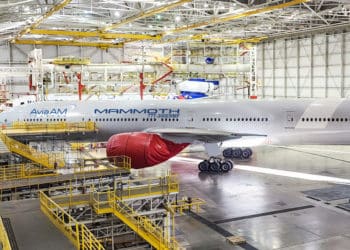How important is Amazon to the US domestic air freight and express business?
Amazon is big. In 2018, the company’s share of US e-commerce sales reached around 50%. E-commerce itself accounts for about 15% of total US retail spending.
But how big is Amazon for the domestic air freight and express business? And has Amazon’s growth come at the detriment for FedEx and UPS?
To be clear, Amazon has a massive shipping bill and as the company has grown its sales, this number has gotten bigger: US$27.7 billion in 2018, or about 12.6% of operating expenses. That spend was 28% higher than in 2017, and 2017 was 34% higher than 2016. Amazon’s shipping bill includes sortation, delivery centers and transportation costs for both North America and International operations. North American net sales accounted for about 65% of total revenue in 2018. Assuming North American spend is proportional to its revenue, Amazon appears to have spent somewhere in the vicinity of $18 billion to ship around North America last year.
Neither FedEx nor UPS provides much commentary on the importance of Amazon to their businesses. In FedEx’s earnings conference call, President and COO Rajesh Subramaniam brushed off Amazon’s potential to disrupt the transportation industry, pointing out that Amazon accounted for less than 1.3% of their total revenue (of $69 billion). Based on the most recent 12 months that would equate to approximately $900 million. This is “substantially lower” than what UPS carries, Subramaniam said.
But UPS does not even mention Amazon in its annual report, although many analysts believe the UPS is more exposed to Amazon than FedEx. In late April UPS Chairman and CEO David Abney brushed off concerns, pointing out that there was “so much more to e-commerce than Amazon” and added that he did not believe there had been loss of revenue to UPS due to Amazon’s switch to other arrangements. UPS’s 2018 annual report makes no mention at all about Amazon. UPS did state, however, that no individual customer generated more than 10% of its total revenue. The company’s revenue in 2018 was just under $72 billion.
Finally, USPS has noted with some concern that Amazon, as well as Walmart’s and Target’s moves to implement last-mile services, will create additional competition for the postal service. Although not naming Amazon directly, USPS implied that in 2018 it generated 8.3% of its revenue — about $5.8 billion — from Amazon.
Most of Amazon’s spend is on ground and last-mile transportation and does not affect air operations. In that sense, it is difficult to pinpoint exactly how much of this spend is on domestic air transportation.
What we do have a good idea of is Amazon’s spend on dedicated air capacity to support its network. Starting in September 2015, Amazon has been building its own dedicated air network to support its operations with five 767s operated by Air Transport Services Group (ATSG). Within three years this network has grown to a total of 20 767-200s and 767-300ERs operated by ATSG’s subsidiaries ATI and ABX, and another 20 767-300 freighters operated by Atlas Air’s subsidiary Southern Air.
Just before Christmas 2018, Amazon signed a deal with ATSG for an additional 767-300ERs and in early 2019 began adding the first of up to 20 737-800BCFs to be operated by Southern Air. Cargo Facts Consulting estimates that the total value of Amazon contract flying by Atlas and ATSG in 2018 was approximately $625 million. This compares to $414 million a year earlier and under $200 million in 2016. At present, this figure represents less than 2% of the total value of the US domestic air freight and express market.
Is all of this bad for FedEx and UPS? So far it doesn’t seem so. Amazon — like low-cost carriers in the passenger business — has grown the size of the pie, so there have been benefits all around. With at least five more 737-800BCFs and additional 767-300Fs entering the Amazon Air operation soon, the e-commerce company’s outlay for contract air cargo will continue to increase in 2019.
But that’s in 2019. The deeper question is, what happens when e-commerce growth becomes more mature and the growth rates of 20% to 30% per year end?
Later this year, Cargo Facts Consulting will publish a comprehensive report on what the domestic, intra-regional and cross border e-commerce business means for the demand for air cargo capacity.
Frederic Horst is the Managing Director of Cargo Facts Consulting. He can be reached at fhorst@cargofacts.com. For more commentary on Amazon see also our subsequent post on the company’s operations in Europe.




